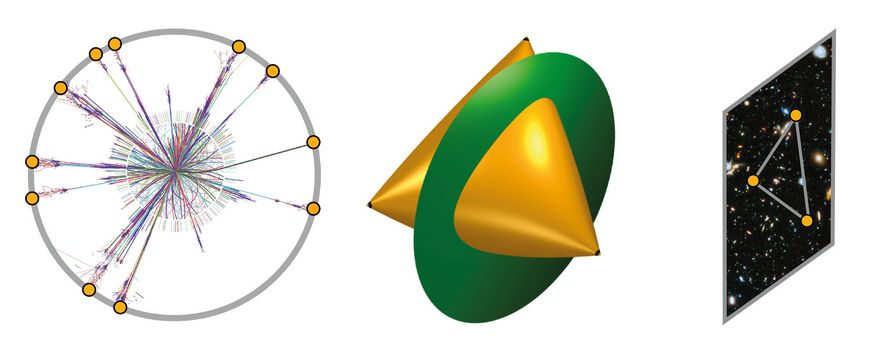UNIVERSE+: Hidden geometry of physical laws
The UNIVERSE+ project is led by Nima Arkani-Hamed (IAS, Princeton), Daniel Baumann (University of Amsterdam), Johannes Henn (MPI for Physics), and Bernd Sturmfels (MPI for Mathematics in the Sciences, Leipzig).
“Our team aims to create a new mathematical language”, says Johannes Henn, the coordinating principal investigator of the project. “The goal is to describe physical phenomena on all scales, from the interactions of elementary particles to the large-scale structure of the Universe.”
Spacetime and quantum mechanics lie at the heart of physics, and have led to a spectacularly successful understanding of the laws of Nature. However, these pillars of fundamental physics are expected to be only approximate notions that ultimately must arise from more basic concepts. This is seen most dramatically at the Big Bang singularity, where the notion of a smooth spacetime breaks down.
Recently, novel geometric shapes called “positive geometries" were discovered in the data describing the scattering of elementary particles and the correlated positions of cosmological structures on the sky. “We believe that these positive geometries have caught the tiger by the tail," says Nima Arkani-Hamed, “giving us the first concrete examples of the way in which the principles of space-time and quantum mechanics can arise from more basic mathematical principles."
So far, however, these positive geometries have only been found in simplified toy models of the physical world. The aim of the UNIVERSE+ collaboration is to fully understand and expose these new ideas, and to find the geometries relevant to the real world, including gravity and the expanding universe.
These developments in physics are closely tied to significant advances in mathematics. “Positive geometries are fascinating objects in their own right, independent of the physical settings in which they were discovered," says Bernd Sturmfels. “I believe that Positive Geometry has a very bright future with great potential to become a vibrant new field at the interface of physics and mathematics. To achieve this requires a coordinated effort by physicists and mathematicians in the years to come, which has now received a significant boost by the ERC Synergy Grant for the UNIVERSE+ Collaboration."
The Principal Investigators of UNIVERSE+ bring together complementary expertise in particle physics, cosmology and mathematics. This is the first collaboration of its kind, made possible by a recent confluence of critical insights in both mathematics and physics. The group aims to attract some of the brightest young people from diverse backgrounds to work on a multi-faceted research program with the potential for significant impact on a wide range of scientific topics in particle physics, cosmology and outward-looking mathematics. They will soon be advertising positions for researchers to join the team.
DarkQuantum: Quantum sensors for the search for dark matter
This project, funded with almost 13 million euros, is led by the University of Zaragoza (lead coordinator Igor García Irastorza), with other main partners being the CNRS in France, the Finnish institution Aalto Korkeakoulusäätiö SR, and the Karlsruhe Institute of Technology (KIT). The MPP is one of four other partners, with Babette Döbrich's group receiving funding of several 100,000 euros. The researcher has already secured a 1,1-million-euro ERC Starting Grant in 2018.
The goal of DarkQuantum is to develop novel quantum sensors that can detect previously purely hypothetical axion particles.These sensors are based on recent technological advances - similar to those that led to the development of qubits for quantum computers. These technologies enable the construction of systems that are highly sensitive to minute electromagnetic radiation. Unlike conventional sensors, this produces only a small amount of background noise that could mask the actual signals. DarkQuantum is relying on this innovative approach to clarify the existence of axions.
The newly developed sensors will be used in two experiments: One will be installed in Canfranc's underground laboratory. The second experiment is the BabyIAXO detector, in which Babette Döbrich's group is also involved. This project is currently being realized as part of the International Axion Observatory (IAXO) at DESY in Hamburg. "If the Axion dark matter hypothesis is correct, DarkQuantum has a real chance of detecting these particles," says Babette Döbrich. “The detection of the axion would have drastic implications for particle physics, cosmology and astrophysics."
About the ERC Synergy Grants
ERC Synergy Grants fund collaborative projects that, due to their complexity, are carried out by several scientists and their groups to achieve breakthroughs that would not be possible in individual projects. For this purpose, the ERC awards grants in the order of 10 million euros for a period of six years.
![[Translate to English:] Prof. Dr. Johannes Henn and Dr. Babette Döbrich (Photos: A. Griesch/MPP; privat))](/fileadmin/_processed_/9/5/csm_Henn-Doebrich_5422bab4ab.jpg)
